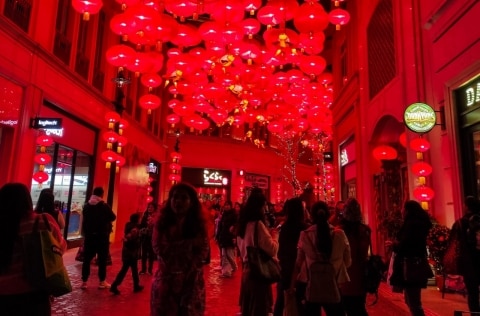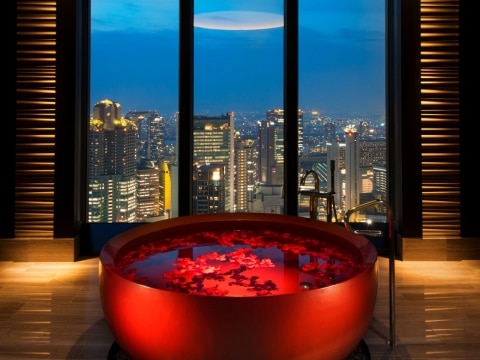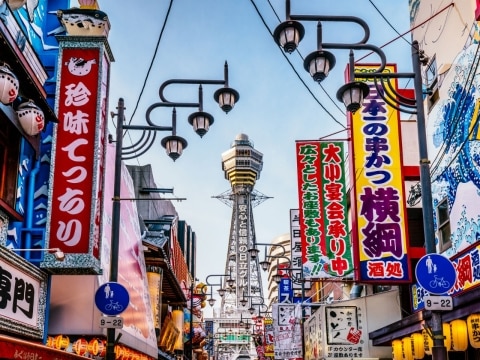20 Reasons Osaka is Japan’s Most Fascinating City
From creating personalised cup noodles at the Momofuku Ando Instant Ramen Museum to visiting the world's largest fish at Kaiyukan aquarium. Here are 20 of the best things to do in Osaka.

The Dōtonbori district
1/21Running parallel to the Dōtonbori-gawa Canal, this colourful area has a history dating back to 1612. It’s been the city’s entertainment precinct since 1662 when playhouses and theatre companies began to populate the southern bank, followed by restaurants and teahouses, which took up residence on the northern side. Today, it remains the heart of nightlife in Osaka with a neon-lit energy that sustains the party all night long.

Sumiyoshi Taisha
2/21Shintoism predates Buddhism in Japan – the first Shinto texts were written in the 8th century. Shinto shrines like Osaka’s Sumiyoshi Taisha are places of worship where the Shinto gods, or “kami”, are thought to dwell. Sumiyoshi is said to be one of the oldest Shinto shrines in Japan, with a history stretching back to 211AD. The current buildings date from 1810 and they’re a famous example of Sumiyoshi-zukuri design, considered free from any influence from the Asian mainland and therefore purely Japanese in style.

Image credit: Imgur
Momofuku Ando Instant Ramen Museum
3/21Japan has presented the world so many things but is there anything more wonderful than instant noodles? If your student years were sustained by packets of Mi Goreng, we recommend a visit to Momofuku Ando Instant Ramen Museum. At the museum, visitors can create their own personalised cup noodles (from the dough to the cup design and flavour) and even wander down a typical Japanese city street circa 1958, the year the genius invention hit the world.
Osaka Castle
4/21Toyotomi Hideyoshi, a samurai, politician and general of the Sengoku period, had the magnificent fortified castle in Osaka constructed in 1583. He built an imposing, five-storey main tower with a further three storeys beneath the ground, complete with a moat and a tearoom made of gold. Within the six hectare grounds, there are 13 other structures designated Important Cultural Properties by the Japanese government, including the original gates, stone walls, wells and citadels.
Kaiyukan aquarium
5/21Osaka’s Kaiyukan aquarium is a must-see for lovers of marine life and anyone who has never seen a whale shark in the flesh. These gentle giants of the sea are whale-sized carpet sharks that can measure up to 14 metres long and their skin is adorned with pale spots and stripes. Kaiyukan is one of the biggest aquariums in the world and its largest tank, containing the world’s largest fish, is its main claim to fame.
Its regional specialties
6/21Osaka is known as “Japan’s kitchen” (the phrase “kuida-ore”, meaning “to eat oneself bankrupt”, is common). Okonomiyaki, sometimes billed as Japan’s answer to pizza, is a specialty: a thick pancake topped with cabbage and a selection of other items including meat, vegies, cheese and mochi (glutinous rice cake). Takoyaki (fried octopus balls) are another regional winner: balls of deep-fried octopus-stuffed batter flavoured with pickled ginger and spring onion.
Shittenoji Temple
7/21This sprawling temple complex has been rebuilt to its original design several times since it was first constructed in the late-500s by Prince Shotoku. It consists of a main Buddhist temple, a grand five-storey pagoda, a lecture hall with a covered corridor and enormous gates to the south, east and west. The surrounding gardens are enchanting, especially during cherry blossom season, and were designed based upon descriptions of the Western Paradise of the Amida Buddha.
Capsule hotels
8/21Spend a night in a pod stacked above and beneath other pods containing sleeping humans. The uniquely Japanese concept has spread all over the world but in Japan it’s less a novelty and more an effective way of maximising office time or getting some shut-eye on the cheap. Each pod is generally the size of a single bed and equipped with a little bit of storage, power outlets and a TV – if you’re lucky.
Shinsekai
9/21Shinsekai, or New World in English, was constructed in 1912 with New York’s Coney Island as the inspiration for its south end and Paris for its north (it even had an Eiffel Tower that was disassembled in the 1940s before being resurrected due to popular demand). It was left to languish after WWII and developed a reputation as a dangerous neighbourhood. Now there are shopping arcades, restaurants, izakayas and, everywhere, statues of the local mascot Billiken (rub his feet for good luck).
Nakanoshima
10/21Nakanoshima, Osaka’s very first public park, is a 1.5-kilometre stretch of green on an island between two rivers in the centre of town. It’s an urban oasis with a rose garden and it’s edged by institutions including the National Museum of Art, Osaka Science Museum, Osaka City Central Public Hall and Nakanoshima Library. The surrounding Kitahama neighbourhood is one of the main commercial centres of the city with plenty of restaurants and shops.
Image credit: kanpai-japan.com
Namba's lion
11/21Namba, a neighbourhood in Osaka’s south, is famous for its fearsome guardian – an enormous stage set into the open maw of a rather irate-looking lion. Built in 1975, the lion is believed to swallow up evil spirits eradicating bad luck... so it’s a favourite of exam-taking students and lots of locals come tax time.
Kabuki at The Shochiku-za Theatre
12/21This theatre was built in 1923 as the first Western-style theatre in Osaka, and it’s the only remaining remnant of the Dōtonburi of old. The theatre, with its marble columns and red velvet seats, provides an intruiging contrast to the traditional Japanese art that is performed here. Here, visitors can see a traditional Kabuki play, many of which last a whole day (and the classical Japanese language can be mysterious to even native speakers).
Abeno Harukas
13/21Abeno Harukas is, at 300 metres and 62 storeys, Japan’s tallest building. Located in Tennoji in downtown Osaka, the building has a fabulous observation deck that affords visitors 360-degree views of the city. Downstairs, Japan’s largest department store, Kintetsu Main Store, sells anything you can think of, including fine jewellery, sweets and furniture across 100,000 square metres of retail space.
The Osaka Museum of Housing and Living
14/21The Osaka Museum of Housing and Living allows visitors to walk the streets of old Osaka. Step back in time via a reconstructed model of old Osaka from the Edo period (mid-19th century). Visitors can enter the town and visit the stores of merchants, including kimono tailors and cabinetmakers. They can also peek inside homes, the sento (public bathhouse) and the town hall. Image credit: Flickr
Image credit: Flickr
Hankyu Entertainment Park's Ferris wheel
15/21Umeda, a trendy neighbourhood located next to Osaka’s two main train stations, is a business hub and a centre for entertainment, shopping and dining. Its crowning glory is the Hankyu Entertainment Park, or HEP, which comprises six storeys of shopping, restaurants and amusements. Sitting atop the building, 106 metres above the ground, is an enormous Ferris wheel. Lovers beware: there’s a local legend that couples who ride together break up soon after!
Image credit: Flickr
Shopping in Tenjinbashi-suji
16/21The covered shopping precinct of Tenjinbashi-suji is the antidote to Umeda’s modern shopping malls. The longest shopping street in Japan, it runs for 2.6 kilometres and spans three subway stations. Its shops, mostly independently owned and run, sell clothing, groceries, books and more. The street was established in the early Meiji era (1868 – 1912) and locals have been shopping here ever since.
Image credit: Flickr
Hozenji Yokocho
17/21Behind Hozenji Temple, just a stone’s throw from the bustle of Dotonbori, is the quaint, cobbled alleyway of Hozenji Yokocho. Established in the Edo period, it retains its Imperial style and its historical buildings now house izakayas and restaurants. Don’t miss the moss-covered statue of Fudo Myo-o, a Buddhist spirit who survived a WWII bombing that destroyed the temple in which it sat and is now a symbol of discipline and moral character. Locals splash the statue with water for luck, hence the lush green coat.
Image credit: Flickr
Spa World
18/21This is the Japanese kitsch you came for. Spa World is seven storeys dedicated to bathing rituals from around the world. It’s split into an Asian Zone and a European Zone. In Asia, you’ll find traditional Japanese onsen, a Middle Eastern hammam, a Balinese spa and a bathhouse based on the Palace of Persepolis (yes, really). Head over to Europe for the Ancient Rome pool, the Blue Grotto (based on the natural pool in Capri) and a Finnish area complete with faux log cabins.
Bunraku
19/21Bunraku, or Japanese puppet theatre, originated in Osaka in the 17th century. For hundreds of years, the art of puppet-carving has been practiced by a small number of artisans and the performances carried out by puppeteers who train for up to 30 years to master a main character. See the results at the National Bunraku Theatre.
Michelin-starred restaurants everywhere
20/21Well, there are actually hundreds more but within Osaka you'll find over 100 Michelin-starred restaurants, making it the fourth-most Michelin-starred city in the world (and Japan has as many Michelin stars as all the cities in the top 10 combined). So where to start? Depends what you're after. Shunsaiten Tsuchiya and Again are best for tempura, while Amano and Nakatani have fresh, authentic sushi.
Up Next
21/21














